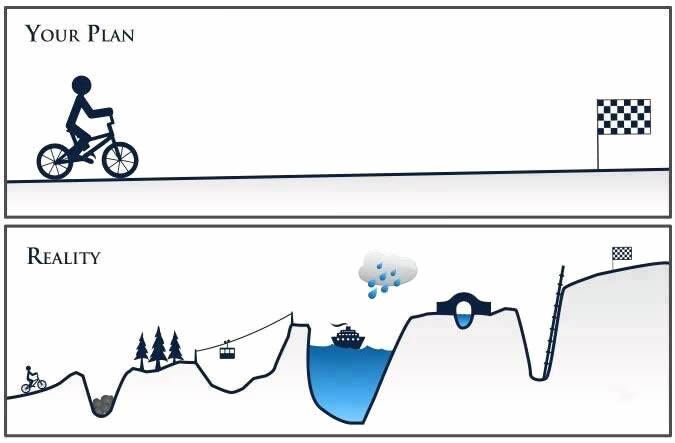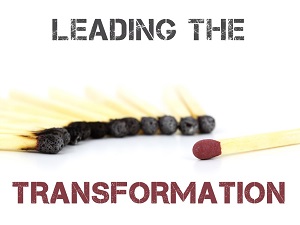Imagine, for a second, that you’ve been charged with leading a business turnaround effort.
To set the scene, let’s say that previous performance was continuing in one direction for a few years now (and it wasn’t UP).
In fact, cost in proportion to sales is the only upward trending line item on the radar.
The writing being on the wall and enterprising competitors have left a mixed and burnt out team.
Worst of all, your Customers have had enough of your inability to deliver on your promises. Not to mention your shareholders’ pain fuelling unwanted media attention and public perception.
Despite all of the history and backyard blazes, there’s a glimmer of hope: the new owners are keen to do what it takes to transform the organisation.
The catch, however, is that the clock is ticking…
What do you do to change the direction of the business?…
Regardless of what you plan to do (and yes, you should comprehensively understand your situation before developing countermeasures to improve), you should start with the realisation that your future is going to look a little like this:

Image Credit: http://www.raymondjames.com
That reality is that the turnaround effort is not for the faint-hearted.
The unfortunate truth is that with business exit rates between 12-14% per financial year, leading a transformation is sometimes unavoidably necessary.
Even if the outlook isn’t grey and instead you are transforming the business for new growth, the journey can certainly be just as ‘scenic’.
Although each situation needs to be approached differently, those with considerable experience tend to prepare for and navigate through typical key transformation phases whether knowingly or not.
How can each ‘unique’ situation have typical transformational stages?
The simple reason is that there is a progression when changing behaviours across an organisation (or any team) to ultimately achieve the performance or target outcomes.
Yes, the actions of your people and your effectiveness of leading the change within that group of people is the key.
This diagram of a solitary cyclist might be a little misleading – but actually in a good way because the truth of the matter is that…
You’re never alone on a transformation journey.
With that in mind, let’s explore how the typical journey might unfold and what you might do to as a leader to it through successfully.
The Quarry – Find The Gems
After you understand the situation and set the destination, mining for resources to support the effort is usually the first step.
In either a turnaround or growth situation, forming a representative team from all areas of value creation is necessary to keeping an end-to-end perspective.
The question then becomes who in (or outside) our organisation has the capabilities, thinking & influence required to help plan and navigate through the landscape ahead of us.
This will most certainly include customers, suppliers, business partners and subject matter experts.
Centering the team around what the end-customer deems as value is an essential element in this phase.
This reference point should guide you and your team to make key decisions through the entire journey. (Never forgetting to listen to those changing needs of the end-customer)
The Forest – Finding Your Way
During a turnaround effort, there will be no shortage of opportunities.
From conjecture to metrics to direct customer feedback, be prepared for collecting the bad and ugly to uncover affinities or patterns.
Before forging ahead with your team towards ‘solutions’ for tactical problems, consider what system or structural root causes are contributing to those large proportions of the broader issues.
The answer you’re looking for, if this was added, removed or improved, would we see breakthrough progress across the board?
How often have you seen elaborate and costly sub-systems created because of a corporate policy, for example? Multiply that by how many business units you have… you get the picture.
For growth, finding your way has all to do with identifying unmet needs and planning to deliver on them with your capabilities & capacity.
This could involve simple enhancements to a product or service, deploying an existing solution in another market segment or starting with a blank canvas – all requiring transformation in some form.
With this opportunity in hand comes creativity. And usually lots of it.
There are a few ways to focus this burst of energy and most effectively tends to steer your team by walking the mountain in reverse.
That is to say, starting from the end-user’s experience (goal of your new product or service) backward through the resources and process required to deliver it.
Do this well enough and you’ll soon enough have a roadmap full of tasks needed to bring those creative solutions to life.
The Valley – Moving Forward
Turning energy into the right action takes inspiration. In most instances, it’s a purpose and examples supporting progress towards it that motivates the team.
Before erecting signs everywhere and redesigning your corporate livery, it’s important to just get on with the first tasks.
Why? Well, without showing that ‘it can be done’, the first wave of momentum will only take you so far by simply explaining this is where you want to go.
As initial efforts are beginning to bear results, usually in a target area first, the large scale deployment will take a significant communication effort to understand the ‘why’ and coordination to make things happen.
This is why your first wins then become extremely important for this phase.
Engaging your team will come through the validated efforts that had the intended impact which supports the purpose. And the higher up the better as there is no substitute for leading by example.
Consider letting those making the wins happen broadcast their wins.
There is almost nothing as powerful in any transformation for peers to overcome their own hesitations after seeing their colleagues overcome what they once thought was impossible.
This will almost certainly allow you to shift up a gear because broader belief in the direction is forming.
The Storm – Staying The Course
As efforts multiply and accelerate, the challenge then becomes keeping momentum through a coordinated effort.
This is also when most turnaround efforts are proven.
Transformational leaders who successfully navigate this phase have prepared for this challenge by building resilience within their teams and providing enabling support.
Whether bailing water or watching for reefs on the horizon, these two factors are critical in your efforts to keep moving in the intended direction and when facing new challenges.
In this sense, resilience simply comes from practice.
When on a path to growth, resilience can strengthen from staying attuned to market needs and conducting product or service innovation pilots to measure customer responses then improving again.
The risks of not challenging the organisation to improve during ‘good times’ are what become clear when a turnaround effort is the only option left.
A persistent effort of building the capabilities to detect & overcome problems is the investment needed to avoid becoming exceptionally good at reacting.
Even capable transformation teams need the right support to allow them to do their part. And, especially by distance, this takes significant preparation and persistence.
Think about your structure as well as hearing the needs of your team to continue being effective.
Do you centralise, de-centralise or use a mixed-model that shifts as the group develops?
What does your hierarchy need to look like to ensure coaches are being coached and are continually learning to do what they do better?
What barriers need to be removed bring team members together to leverage each other?
The changing answers to these questions will take keen perception by the transformation leader throughout the entire effort.
The Bridge – Leveraging Lessons
After staying the course through one of the most challenging phases of your transformation, the waterways you need to cross will seem to have shrunken considerably.
Why is that? Another drought? No, there are a few better reasons.
Having tirelessly supported your multi-disciplined team with a leading example, clear purpose and what they needed to perform in their roles, the progress over the last weeks, months or even years has developed into trust.
This trust has allowed team members to understand what is expected of them and they have confidence that their efforts are visibly marking progression.
Cooperation amongst the team and the broader organisation has also allowed for efforts to have a greater impact.
You’re getting better at making good change.
A small part of your focus can now shift to working further up or down stream and connecting more of the peripheral opportunities to the transformation.
Of course, not at the expense of the efforts still being made within the core business.
Sharing the lessons learned from your progress with your customers, suppliers and partners will start to build a system of transformation for mutual benefit.
And if you have proven your effectiveness well enough, you might even be able to create new value-adding services to offer the market.
The Next Level – Sustaining Maturity
To support your increasing performance and growth, continuing to improve the processes, systems and structure needs to become a core responsibility of everyone in the organisation.
Expect that sustaining your progress will take some time since the habits that are still being taught have yet to become behaviour.
The leader’s role here is to ensure that in all points in the organisation, standards are in place to support the work being done and are being improved when possible.
Leading indicators can then be used to signal where and when support should be provided.
Another vital element of sustaining the changes made is ensuring their relevancy to the needs of the customer, business and team members.
Without doubt, a moving target but not impossible to keep in sight.
Seeing transformation as a large project with a closure, calling the race early or allowing competing priorities to take over tend to be the causes of regression.
Any early move away from this to relieve resources from a transformation effort is a clear sign that the business actually not ready to look forward – only ready to return to where it was.
Copyright © 2015 TWO Consulting


